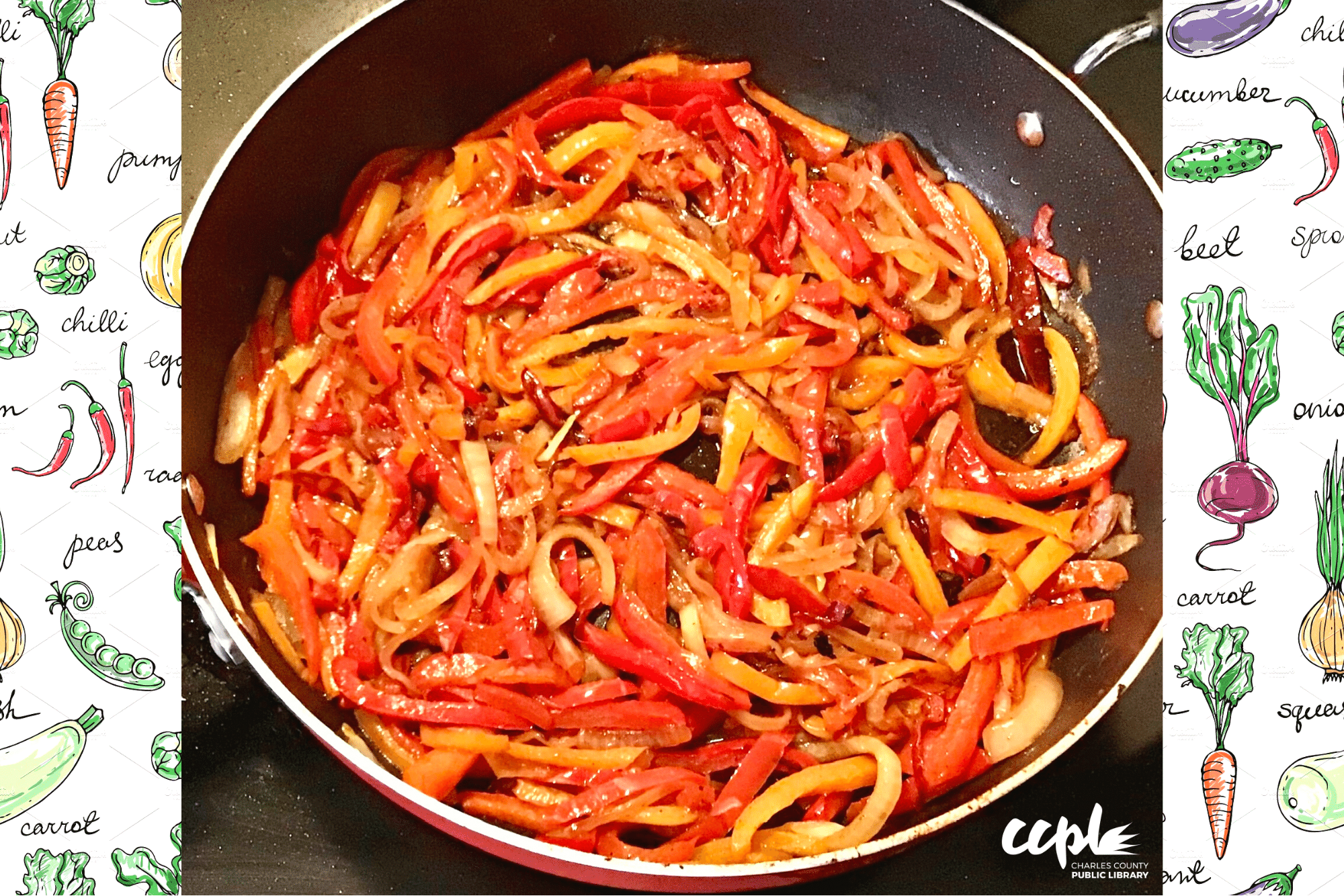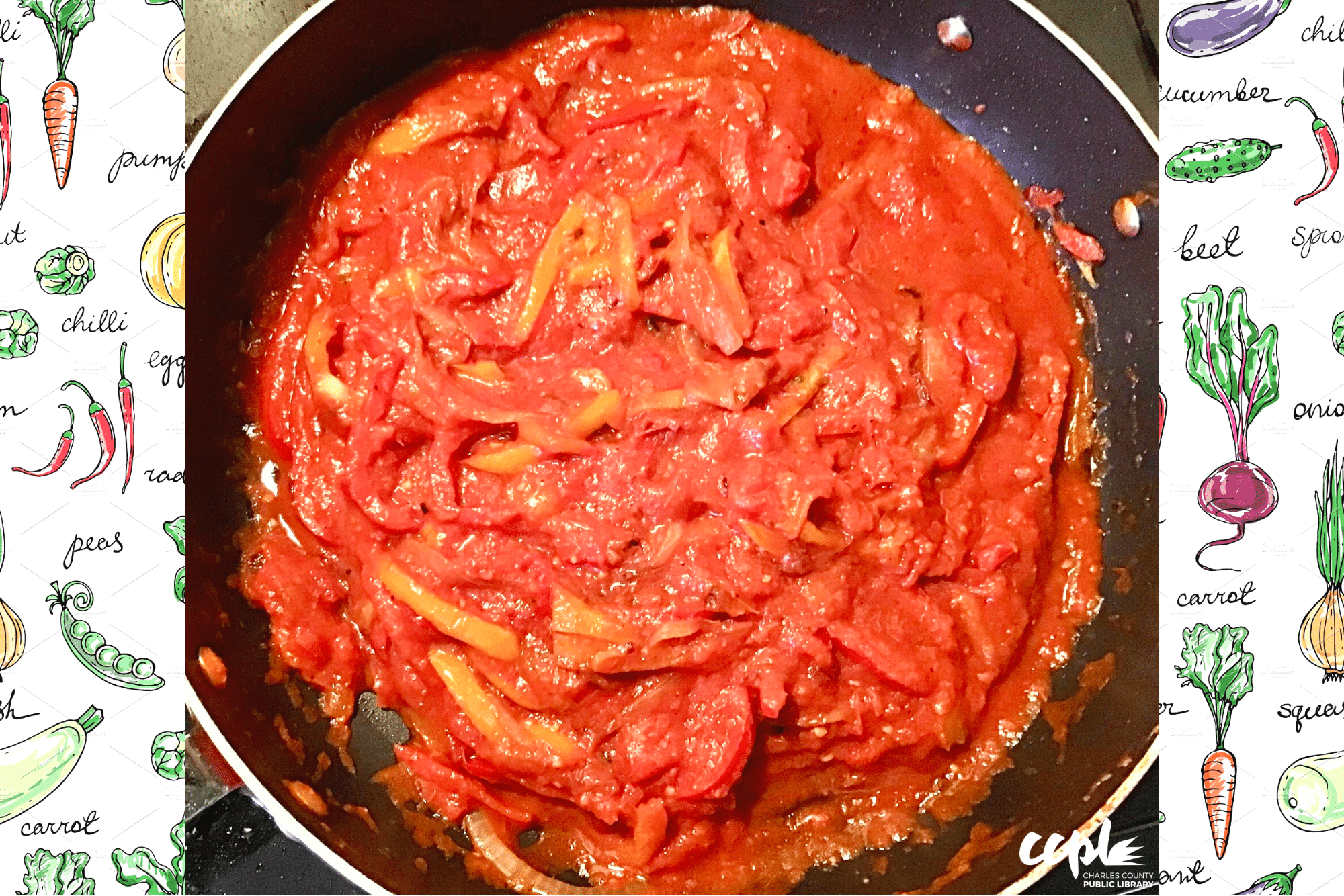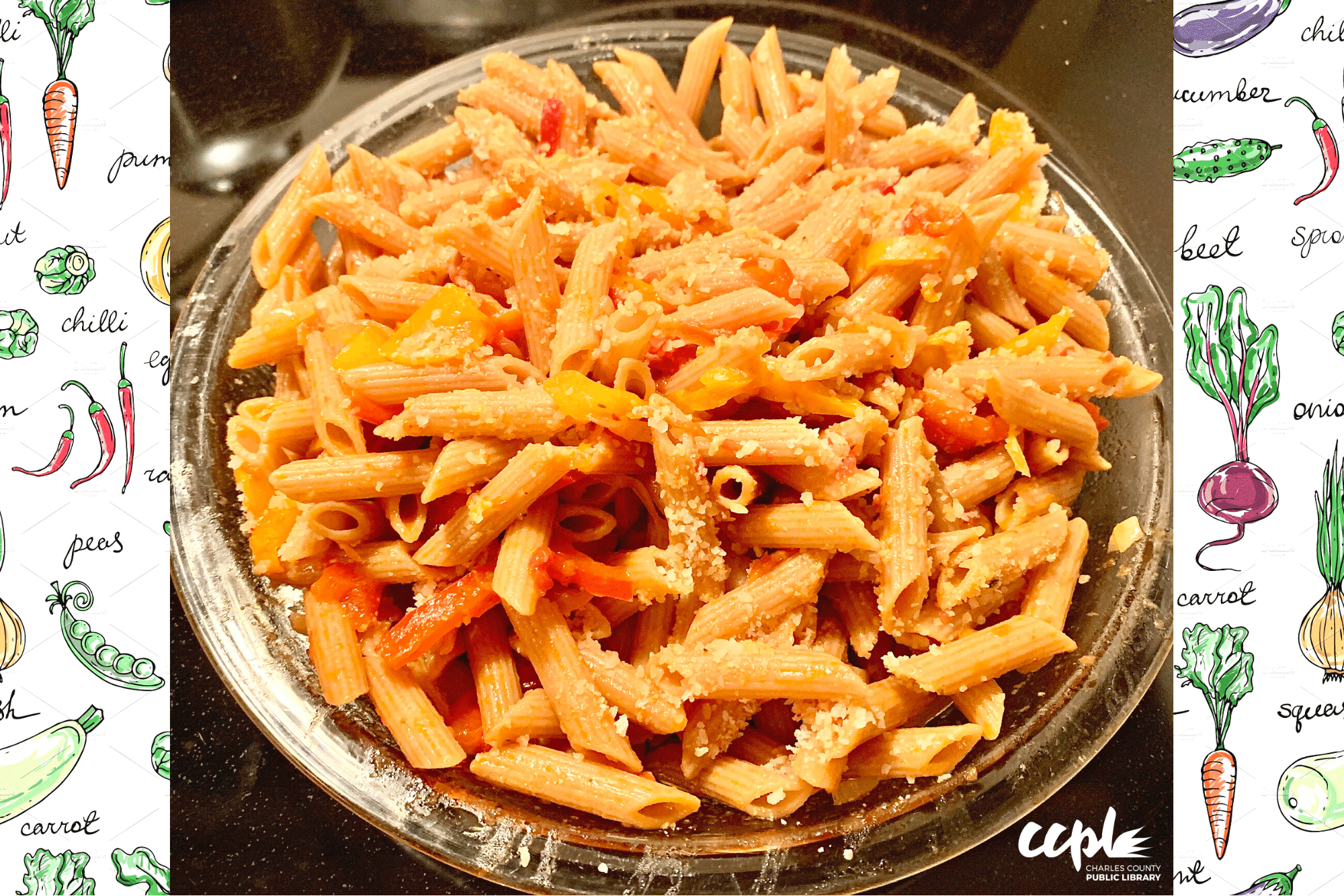
June is National Fresh Fruit and Vegetable Month. Fruits and vegetables are essential to our health and well being ~ they provide so many valuable nutrients that our bodies need including calcium, fiber, folate, iron, magnesium, potassium, sodium, Vitamin A and Vitamin C. Please check out this important fruit and vegetable phytochemical color list here.
In this blog, I will teach you how to build a beautiful and delicious Mediterranean warm grain bowl using fresh fruits and vegetables and dark leafy greens. I will also provide my own photos of healthy meal inspirations for breakfast, lunch and dinner. Then I will outline tips and tricks (courtesy of my friend, Andrea) for effective gardening. Lastly, I will provide a link to resources for fresh local produce available at various Southern Maryland farmer’s markets, farm stands and CSAs (Community Supported Agriculture).

Part I: Mediterranean Warm Grain Bowl
Below is the specific bowl I chose to build, but you can build whatever you desire (there are countless flavor combinations). Of course, if you have specific food allergies – omit those ingredients. Check out these helpful books: Build-a-Bowl: Whole Grain + Vegetable + Protein + Sauce = Meal by Nicki Sizemore and Bowls: Vibrant Recipes with Endless Possibilities by America’s Test Kitchen (which are also linked below in the extensive list of additional resources from our CCPL catalog).
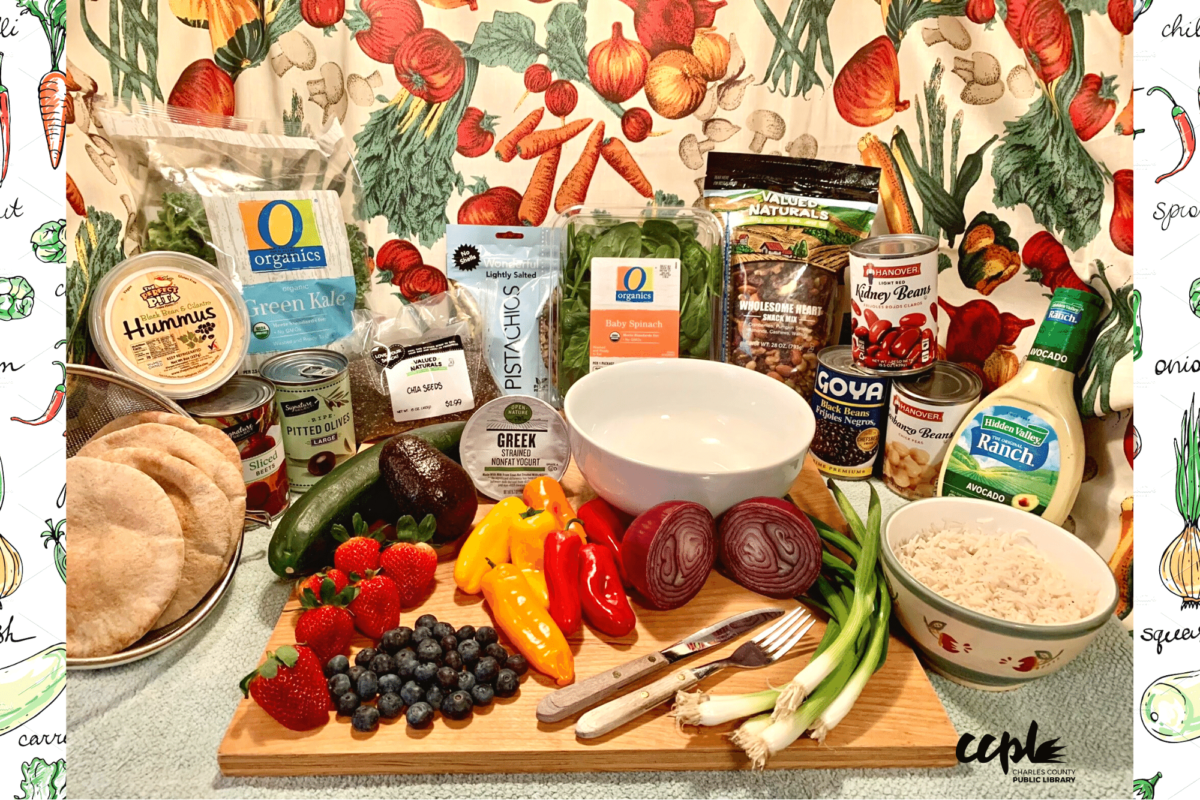
Ingredients:
NOTE: For a vegan-friendly bowl, omit the cheese.
NOTE: For additional protein, you may also include various meats such as rotisserie chicken, grilled/blackened chicken, shrimp, fish, steak, pork, bacon, etc.
Mediterranean Warm Grain Bowl (Directions):

This was my first attempt at building a fruit and vegetable bowl, and it was surprisingly easy…definitely something an entire family can participate in. Teens and even younger children will benefit by being involved, as it’s never too early to teach them the importance of eating healthy. I decided to build a large bowl (enough for 2 or 3 meals, as this will keep well in the refrigerator for up to 3 days and it actually tastes even better leftover, if kept dry). To build the bowl, start by thoroughly washing all of the fruits and vegetables, including rinsing the baby spinach and kale leaves. Chop up your fruits and vegetables – open all of the cans of beans and rinse them in a colander, under cold running water. Portion everything out into small separate bowls, as shown.
For the “warm grain” portion, you can use quinoa (but I decided to use Basmati rice, because I enjoy its trademark earthy, nutty flavor). Here are simple microwave directions to prepare the Basmati rice:
Salt and pepper in the bowl, to taste. 2 cups of water, plus one cup of Basmati rice (be sure and rinse the rice in a colander under cold running water first). Add 1 Tbsp of olive oil. Whisk together and microwave, covered, on full power (#10) for 8 minutes. Then microwave covered for another 8 minutes on low power (#3). Uncover and cool. Makes enough for 4 servings.
As your (hot) grains are cooling, gather the rinsed baby spinach and kale leaves and pat them dry. Chop them into smaller pieces, if desired. Add the leaves into the large bowl and fill it up to the top.

Use a fork to fluff up the warm grains, and portion them on top of the bed of greens (I used 2 servings of Basmati rice).
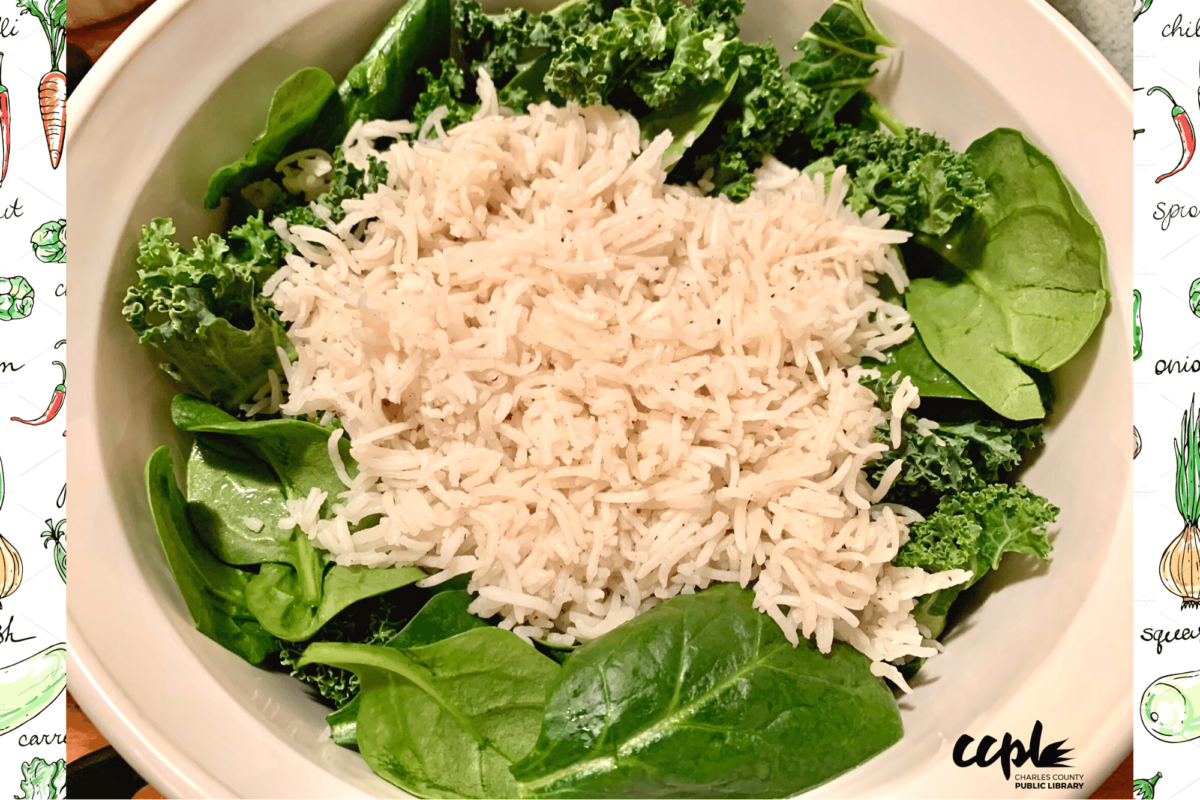
Next, section out your ingredients on top of the warm grain. I was able to fit everything into my large bowl – extra ingredients, such as the beans, were stored in Tupperware containers for the next few days.
*Portion out what you’ll eat into a smaller bowl and add dressings to it, to bind it together. I used Greek nonfat yogurt and black bean and cilantro-flavored Hummus.
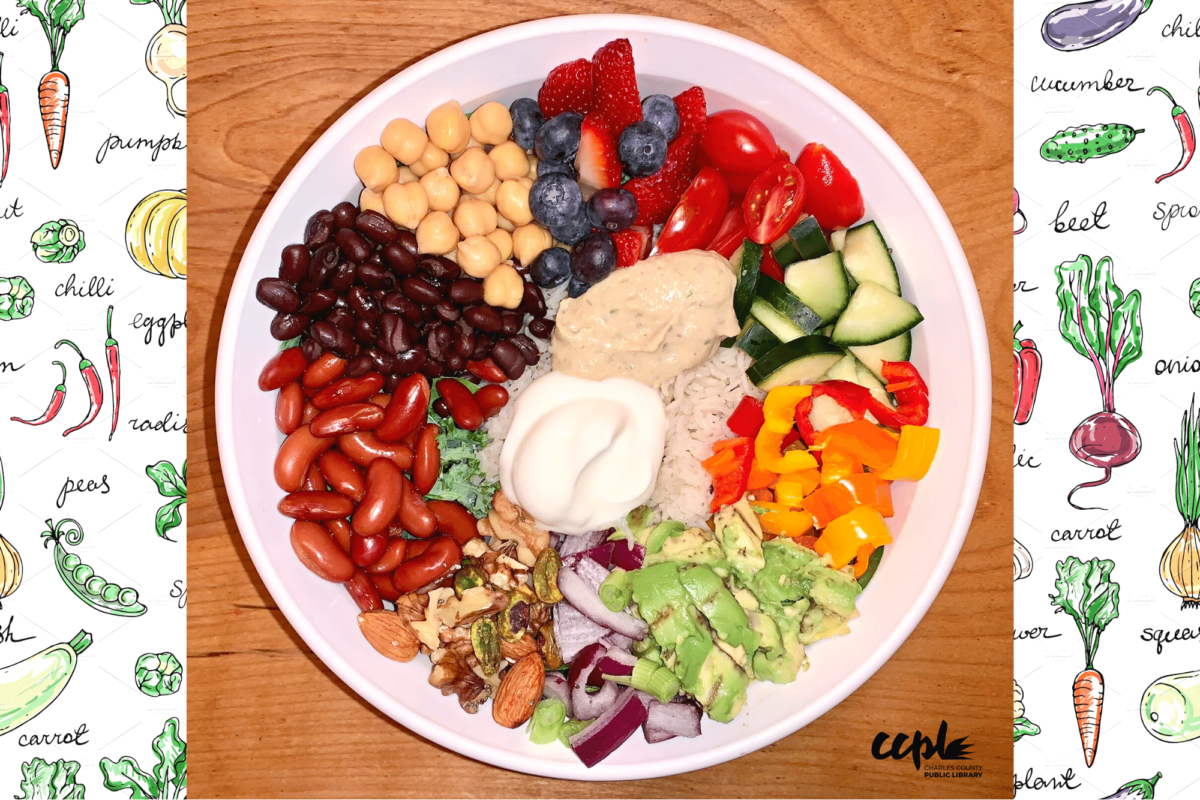
Lastly, mix everything together in the large bowl until all of the ingredients are well incorporated. As previously mentioned, this will keep in the refrigerator (dry) for up to 3 days.
*If desired, you may also use whole wheat pita bread and fill it up with your warm grain bowl ingredients (for delicious sandwiches and/or wraps).

Part II: Healthy Meal Inspirations
Breakfast
(Toasted large whole grain bagel, one whole avocado – mashed – garnished with freshly squeezed lemon juice, sea salt, ground pepper and chia seeds). *If desired, you may also add diced red onions and colorful peppers.

(Quaker instant oatmeal with whole milk, a dash of sugar, strawberries, blueberries, bananas, pistachios, walnuts, almonds, pepita pumpkin seeds, chia seeds and a large scoop of peanut butter for protein).
- NOTE: If allergic to peanut products, substitute another nut butter, such as almond butter. Sunbutter (a sunflower butter) may also be used in place of the peanut butter.

(3 extra large eggs with white American cheese, baby spinach leaves, tomatoes, chopped red onions and green scallions, red, yellow and orange peppers, sea salt and ground pepper).
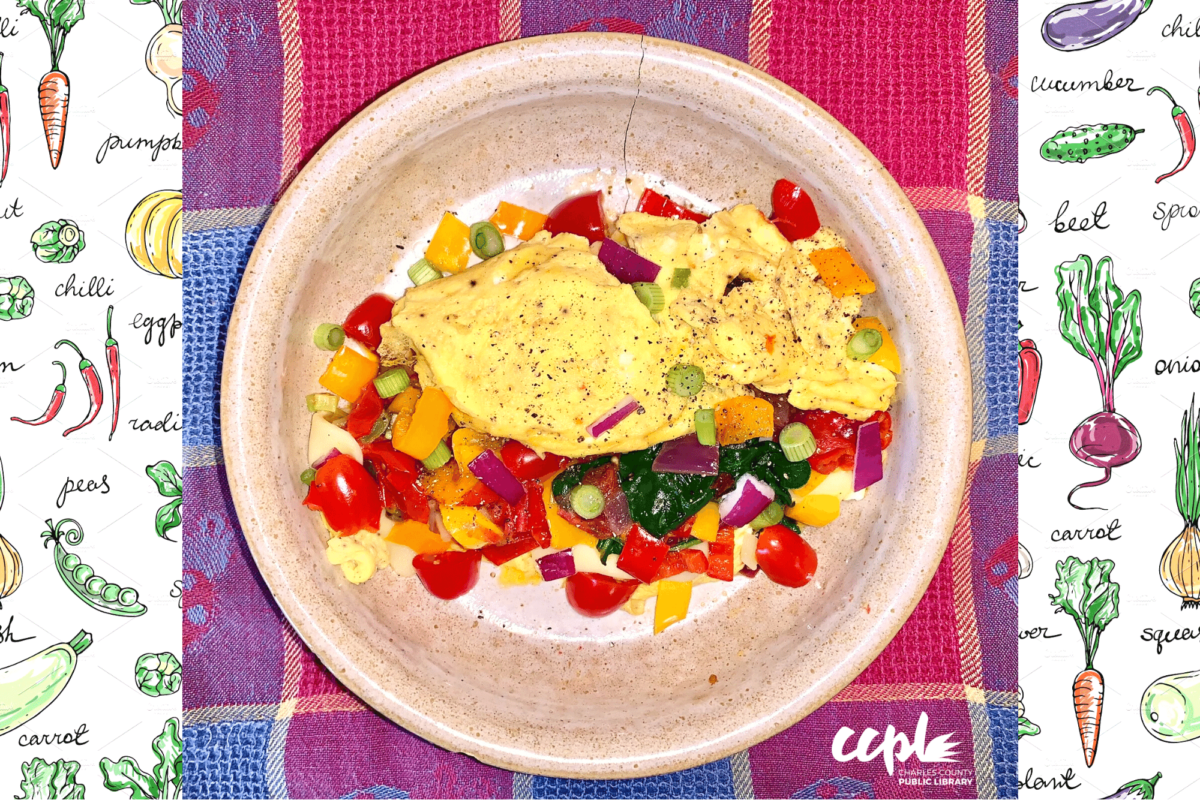
Lunch
(Toasted whole grain oatnut bread with white American cheese and Colby Jack cheese, grape tomatoes, red onions and green, red and yellow peppers). *If desired, you may also serve it with hot soup, such as creamy tomato soup.
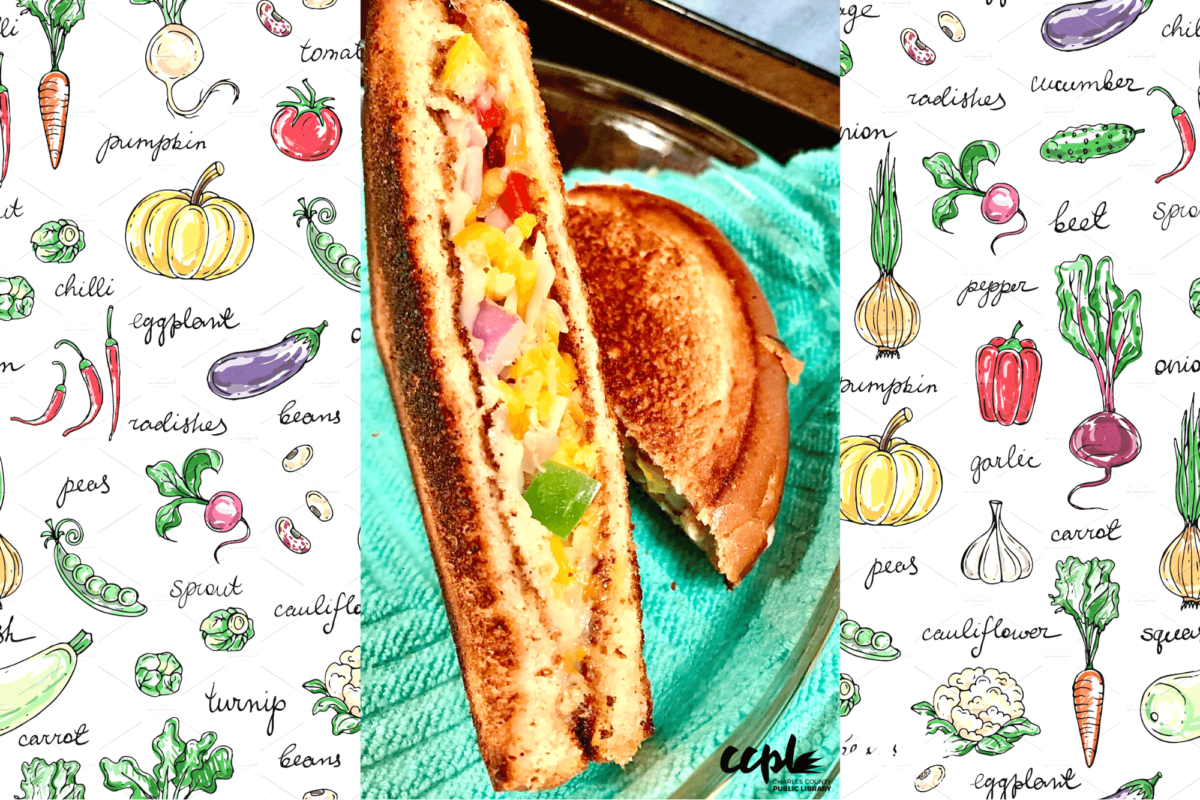
(Ground turkey meat, crushed Tostitos corn chips, avocado, dark red kidney beans, black beans, red onions, green peppers, red peppers, grape tomatoes, shredded lettuce, Colby Jack cheese, salsa, McCormick’s Taco seasoning, Avocado Ranch dressing). *I prefer using ground turkey meat because it’s leaner and healthier for you. If desired, you may substitute ground beef OR for a vegan-friendly option…omit all meat.
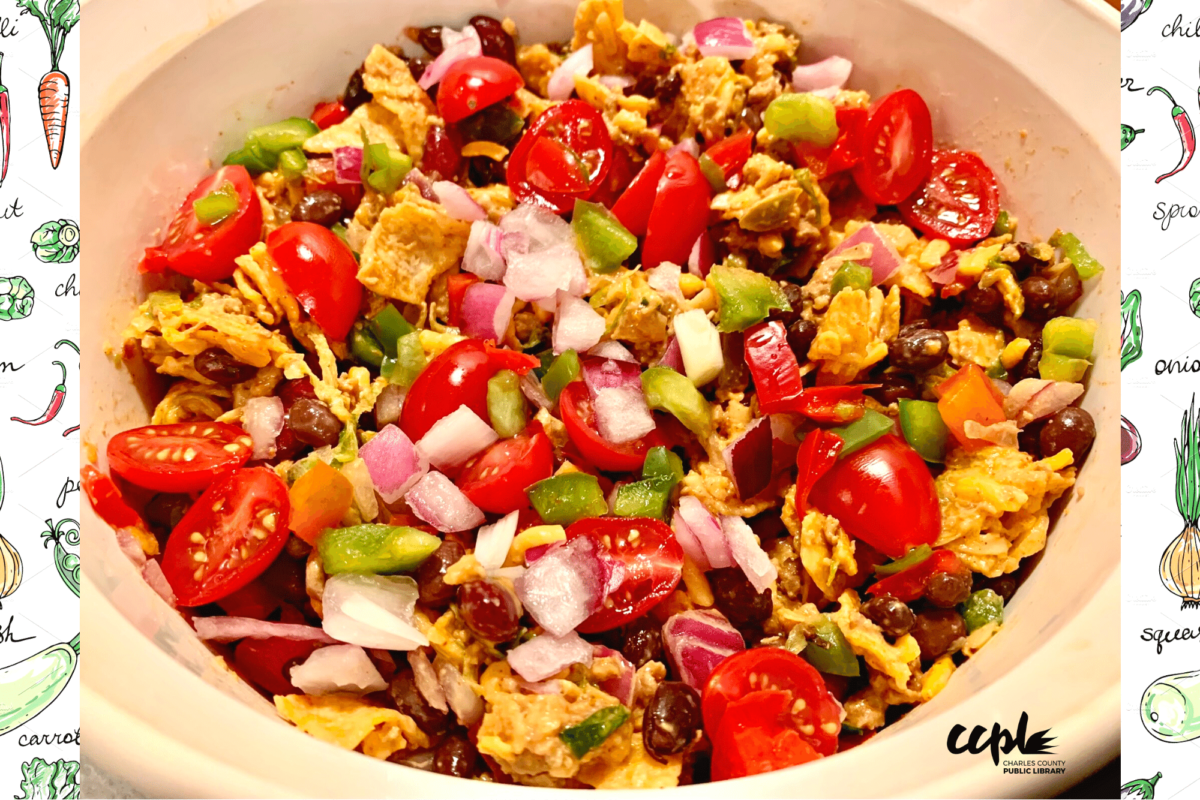
Pastas
For pasta lovers, a quick and easy meal involves sautéing peppers with onions in olive oil and then mixing in a tomato sauce (you can make your own sauce, but I love to use the brand RAO – my favorite flavor is their Vodka Sauce). Once you’ve finished making your sauce, store any extra in a Tupperware container in the refrigerator (it will keep for several days). You can add this sauce to cooked pastas such as fettuccine and penne. *I prefer using whole wheat pasta, because it’s healthier and high in fiber.
(Whole wheat penne with white American cheese, chopped red onions, grape tomatoes and topped with chia seeds and Panko breadcrumbs, for crunch).
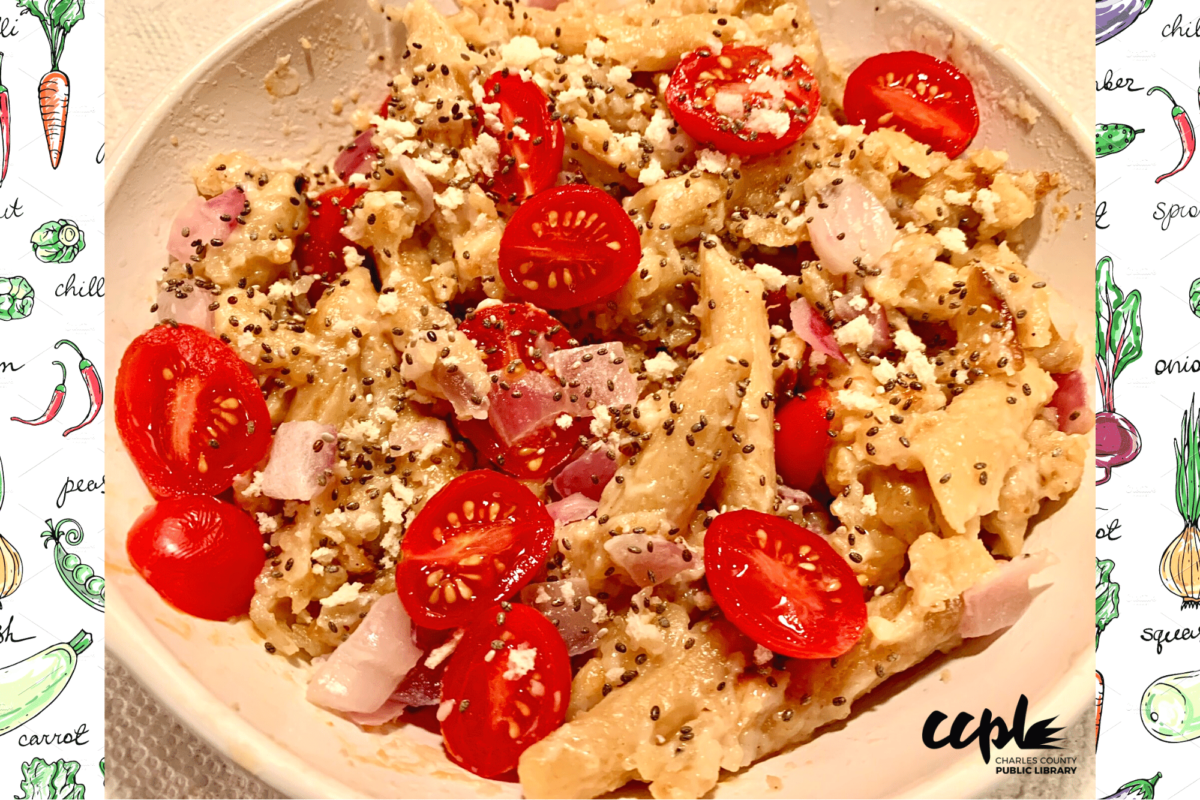
(Whole wheat penne tossed with olive oil paired with baby spinach – drizzled with freshly squeezed lemon juice – topped with chia seeds and melted mozzarella cheese).
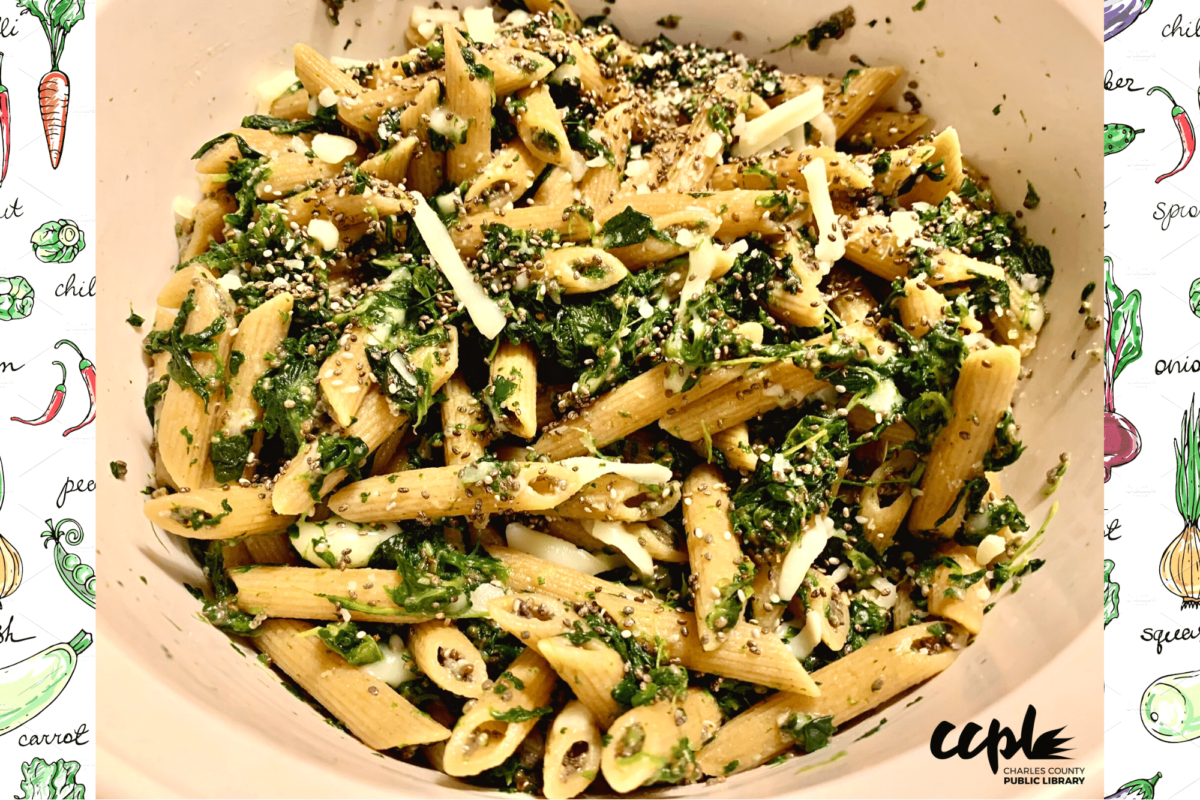
Dinner
(Parmesan crusted tilapia filet paired with steamed carrots and roasted potatoes, drizzled with aged Balsamic vinegar).
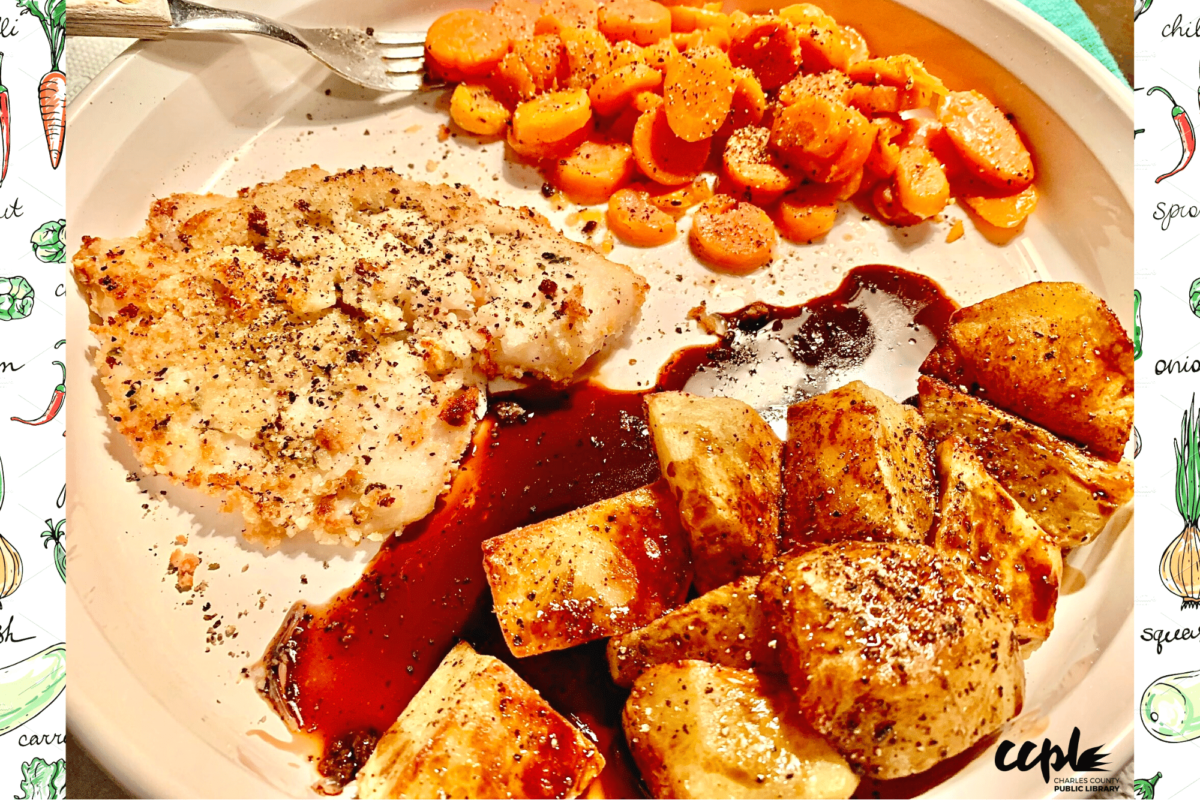
(Rotisserie white meat chicken breast, carrots, peas and yellow onions).

(Rotisserie white meat chicken breast drizzled with aged Balsamic vinegar, paired with cooked baby spinach – drizzled with freshly squeezed lemon juice, and chia seeds). *Not pictured: Homemade buttered cornbread.
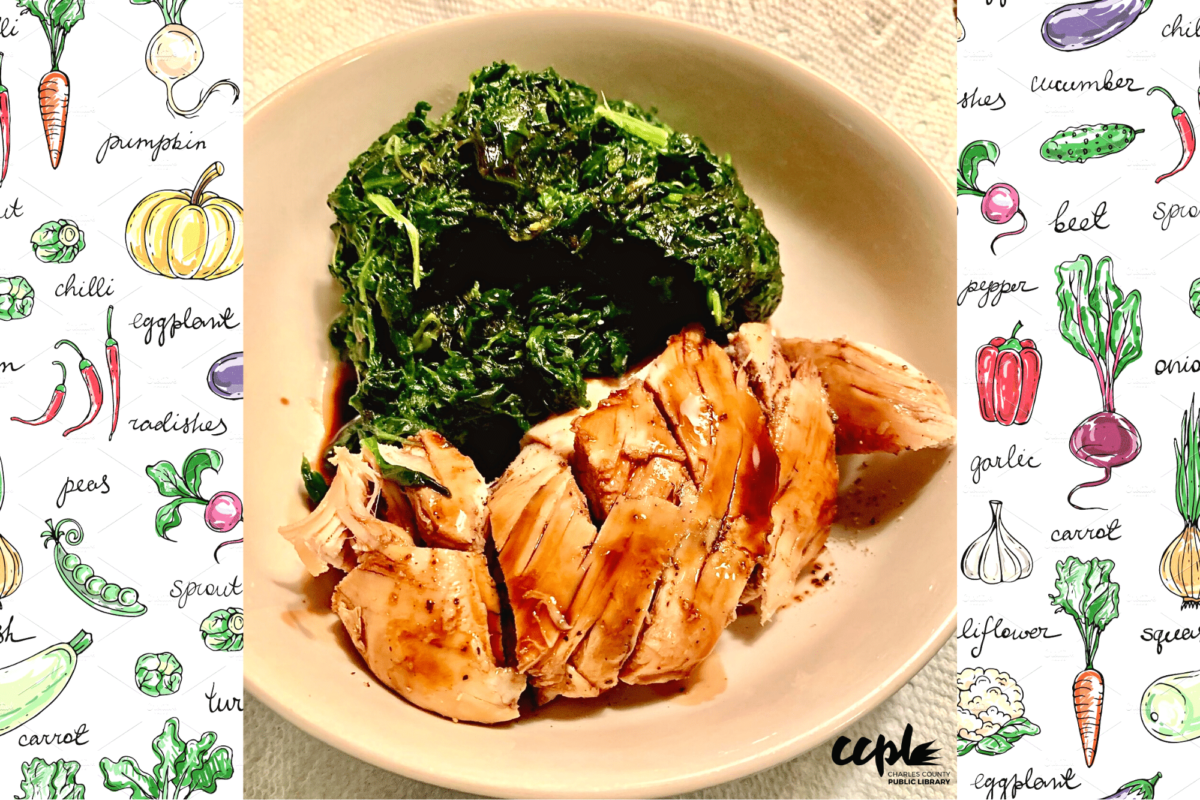
Salads
For salad lovers, here are some attractive and filling options, especially for summer. Check out The Complete Salad Cookbook: A Fresh Guide to 200+ Vibrant Dishes Using Greens, Vegetables, Grains, Proteins, and More by America’s Test Kitchen (which is also linked below in the extensive list of additional resources from our CCPL catalog).
(Baby spinach salad with rotisserie white meat chicken breast, grape tomatoes, apples, mashed avocados, cucumbers, walnuts, cranberries, wonton chunks and feta cheese). *Not pictured: Aged Balsamic vinegar dressing.
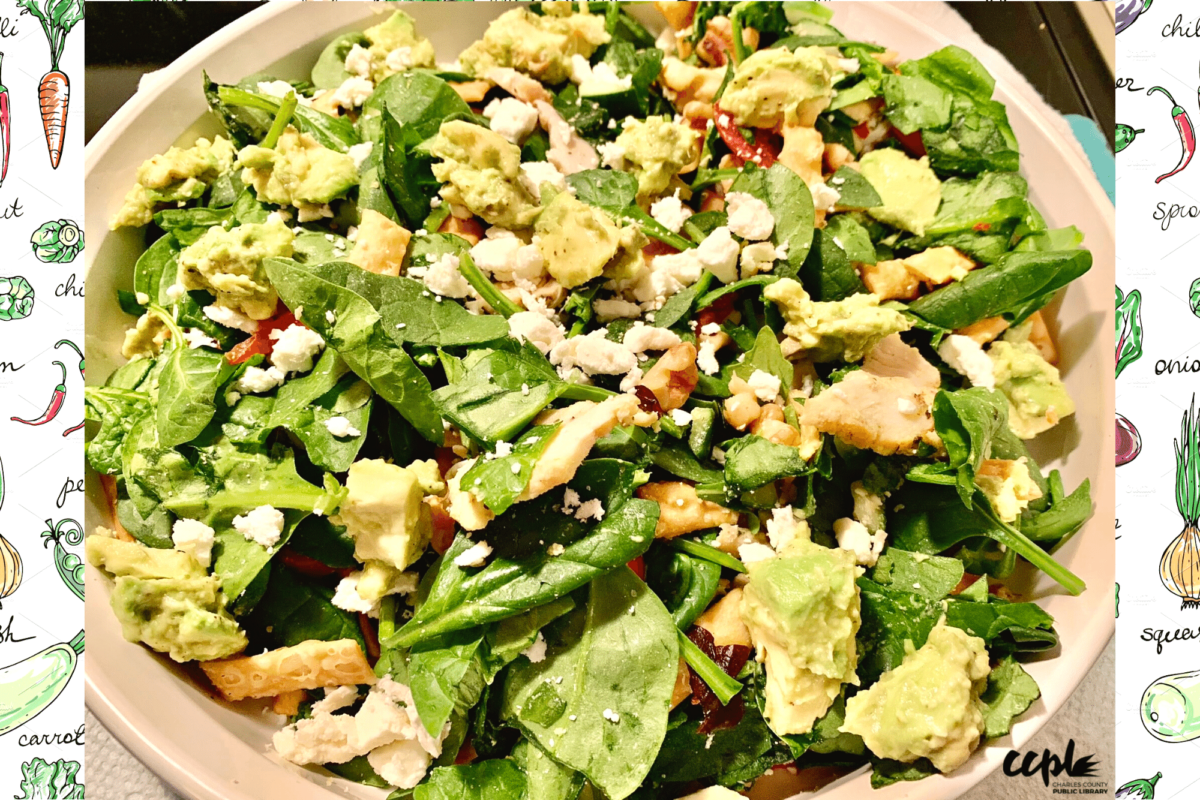
(Arugula salad with mandarin oranges, strawberries, blackberries and beets). *Not pictured: Creamy Italian dressing.
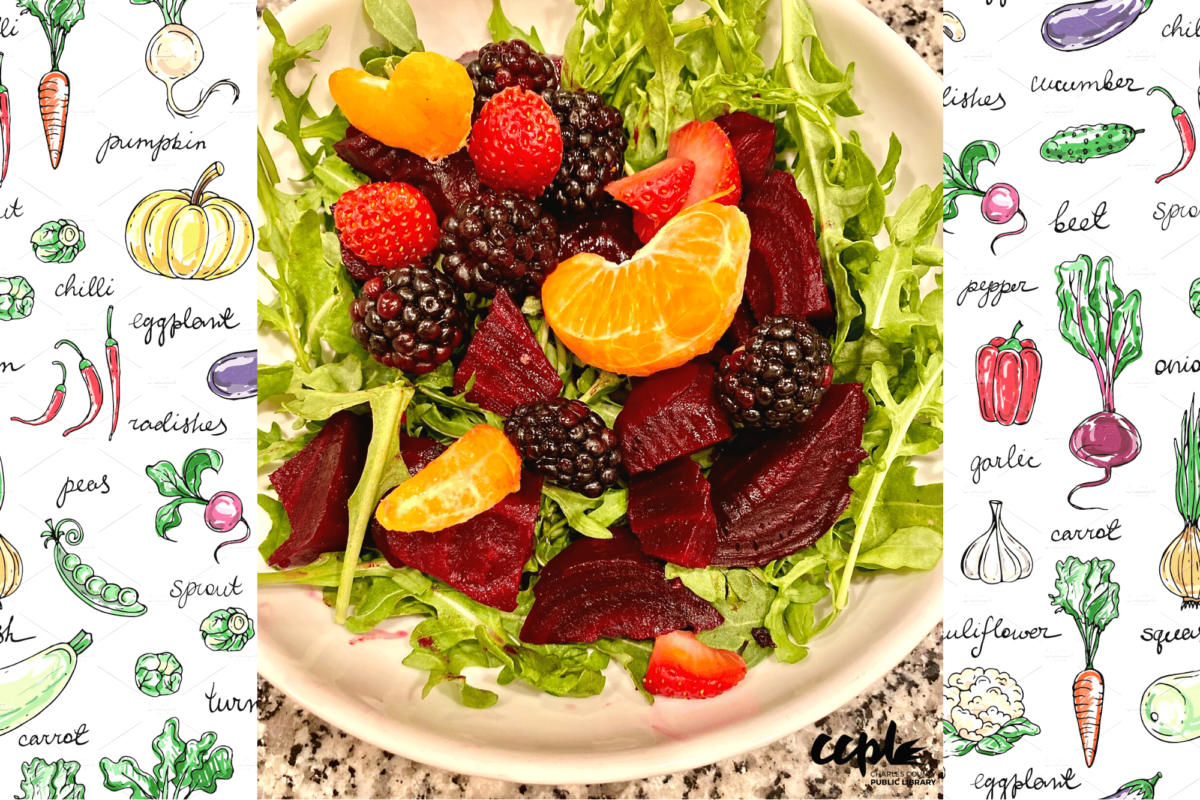
(Beet and peach salad with chopped tomatoes, drizzled with aged Balsamic vinegar dressing).

(Cucumber and tomato salad with roughly chopped red onions, drizzled with creamy Italian dressing).
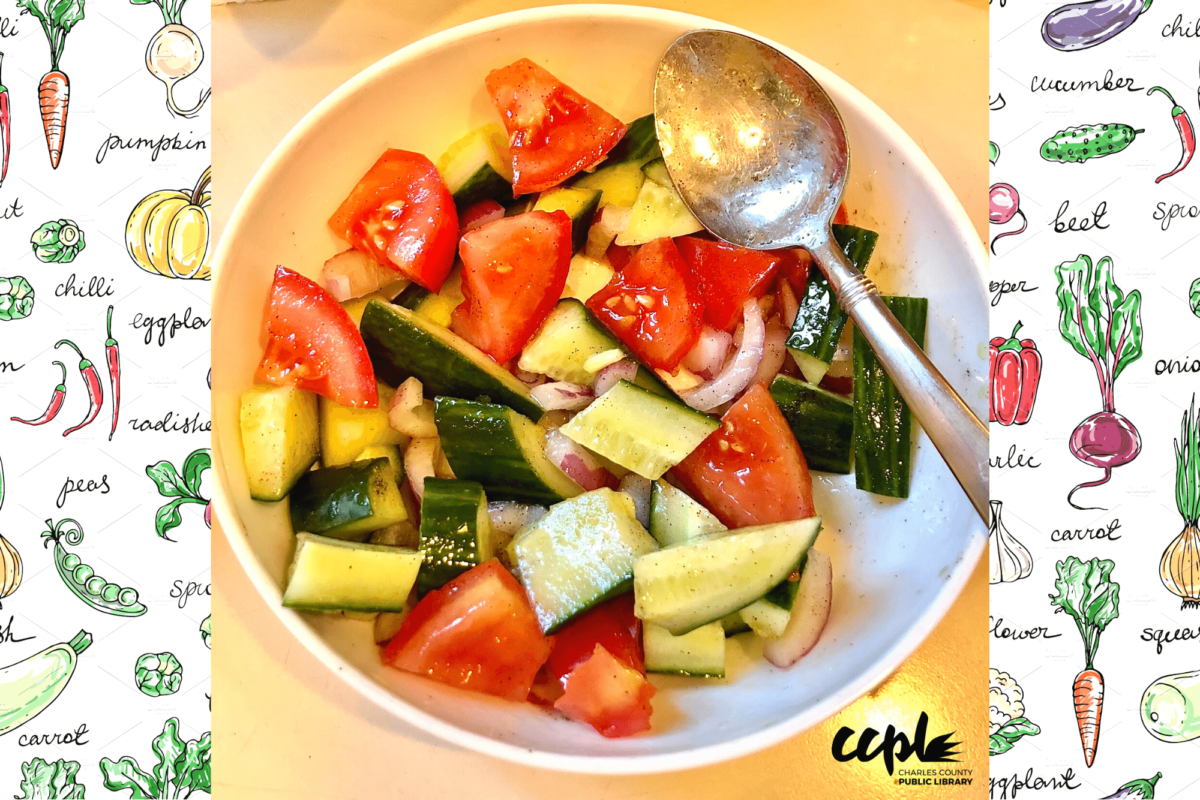
(Red pepper and cucumber salad with chunks of fresh mozzarella cheese). *Not pictured: Aged Balsamic vinegar dressing.
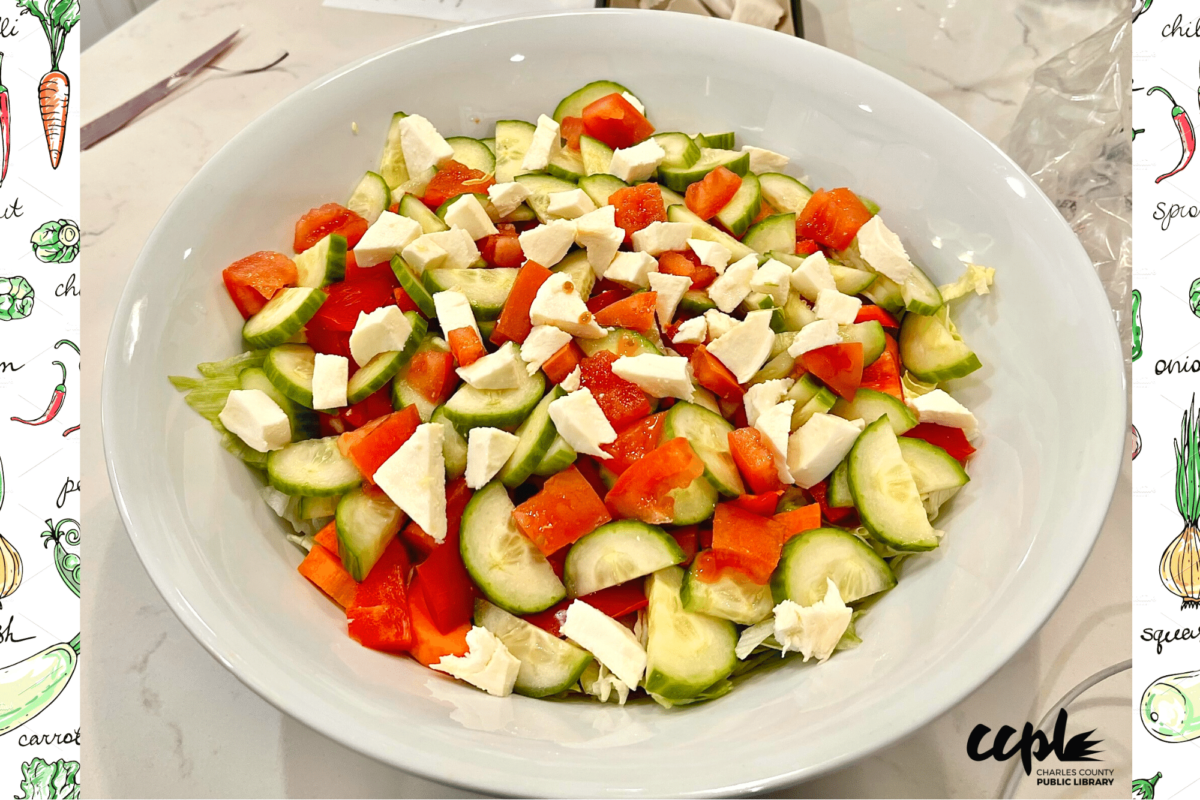
Part III: Gardening Tips and Tricks
With prices steadily rising at the grocery store, many people are turning to gardening as an alternative. Growing your own fruits and vegetables is a smart way to save money and enjoy fresh produce at home. I will outline tips and tricks for effective gardening but first, let me share with you my past gardening mistakes.
A few summers ago, I attempted a small garden (a pepper plant on the left, and four tomato plants). Unfortunately, I’m a novice gardener and I left these plants completely open and vulnerable to hungry predators.
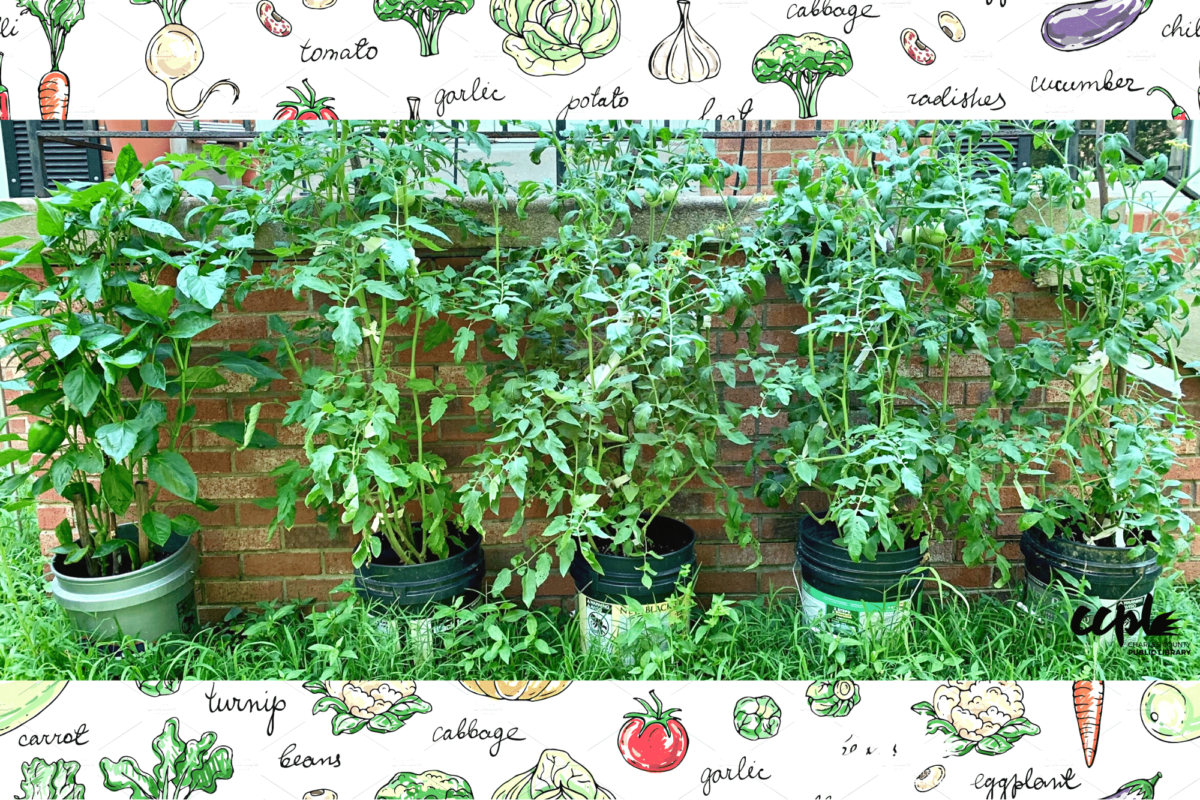
My pepper plant yielded several peppers (which thankfully were left alone by the wildlife).
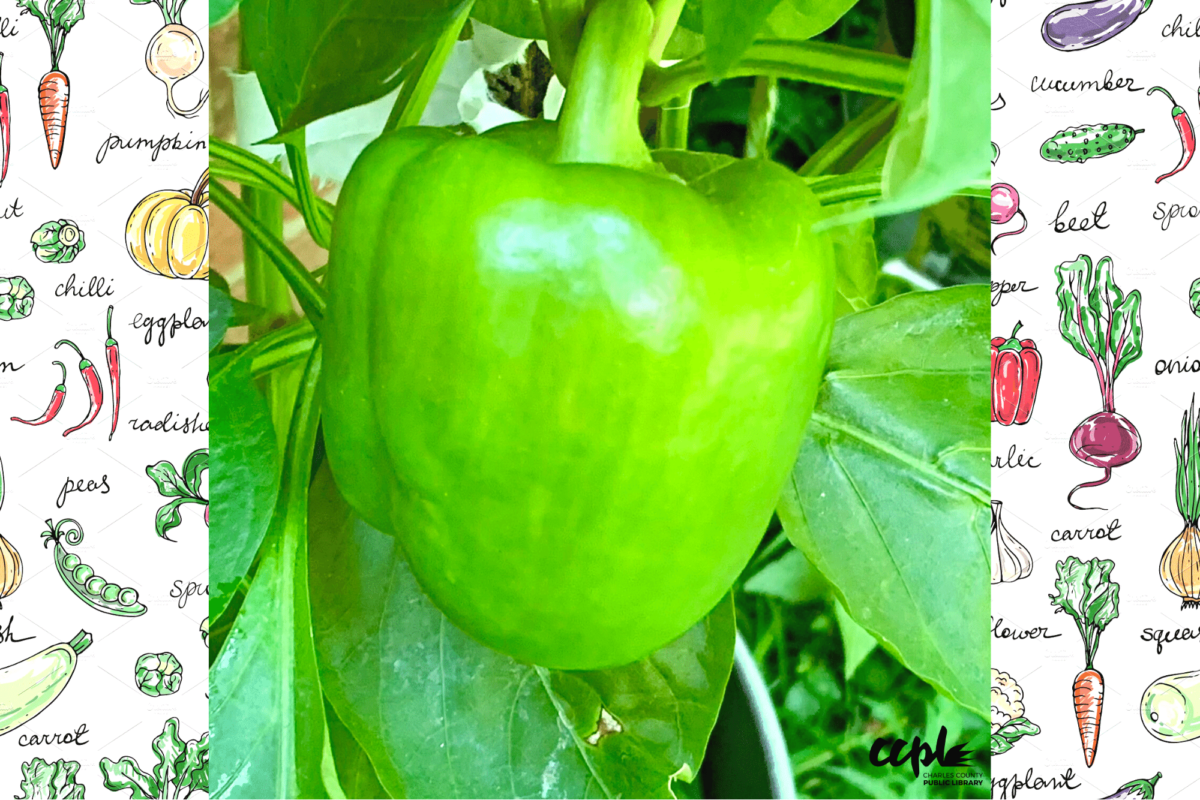
My tomato plants began to yield several green tomatoes which were well on their way to ripening and turning red, when…
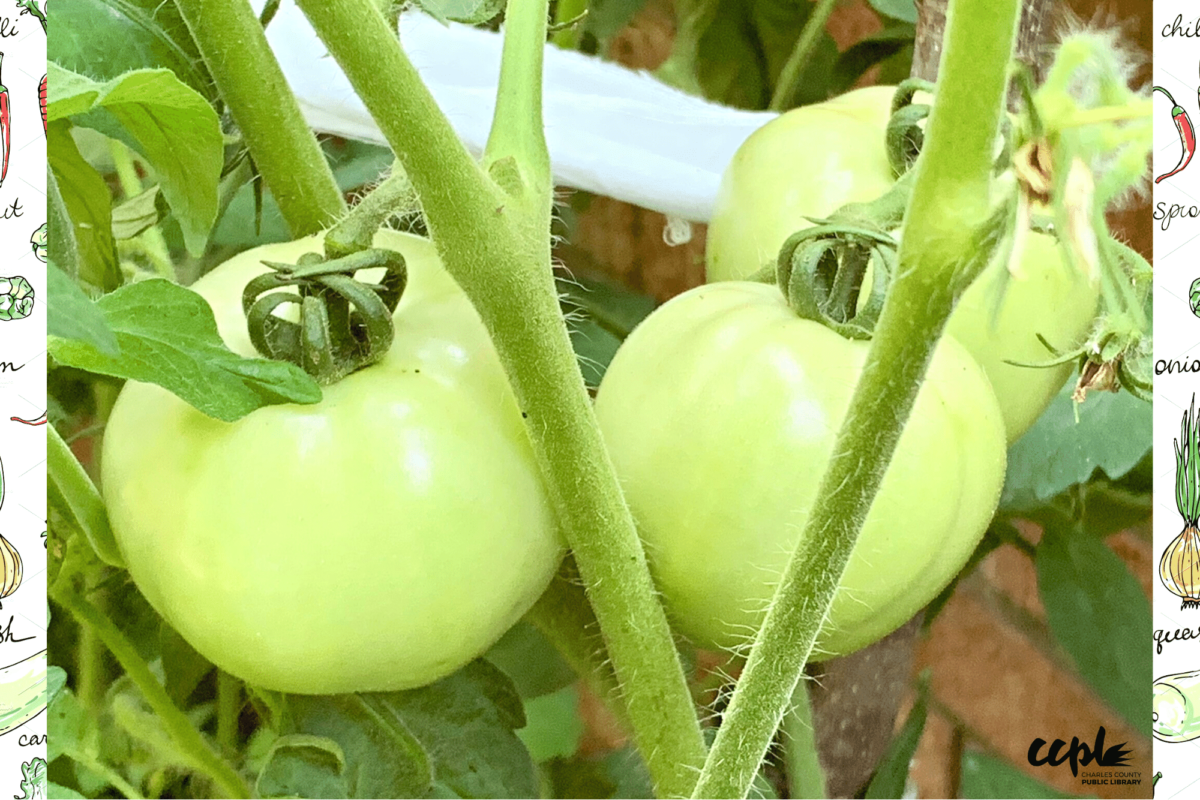
…a fuzzy squirrel tomato thief stole my green tomatoes from their vines before they had a chance to ripen. It took a few huge bites out of them, and then threw them on the ground…letting them roll away.
Another tomato thief I had to contend with was the dreaded tomato hornworm – it rapidly devoured my leaves. Every time I picked one worm off, another one would appear. Needless to say, I barely enjoyed any tomatoes that summer.
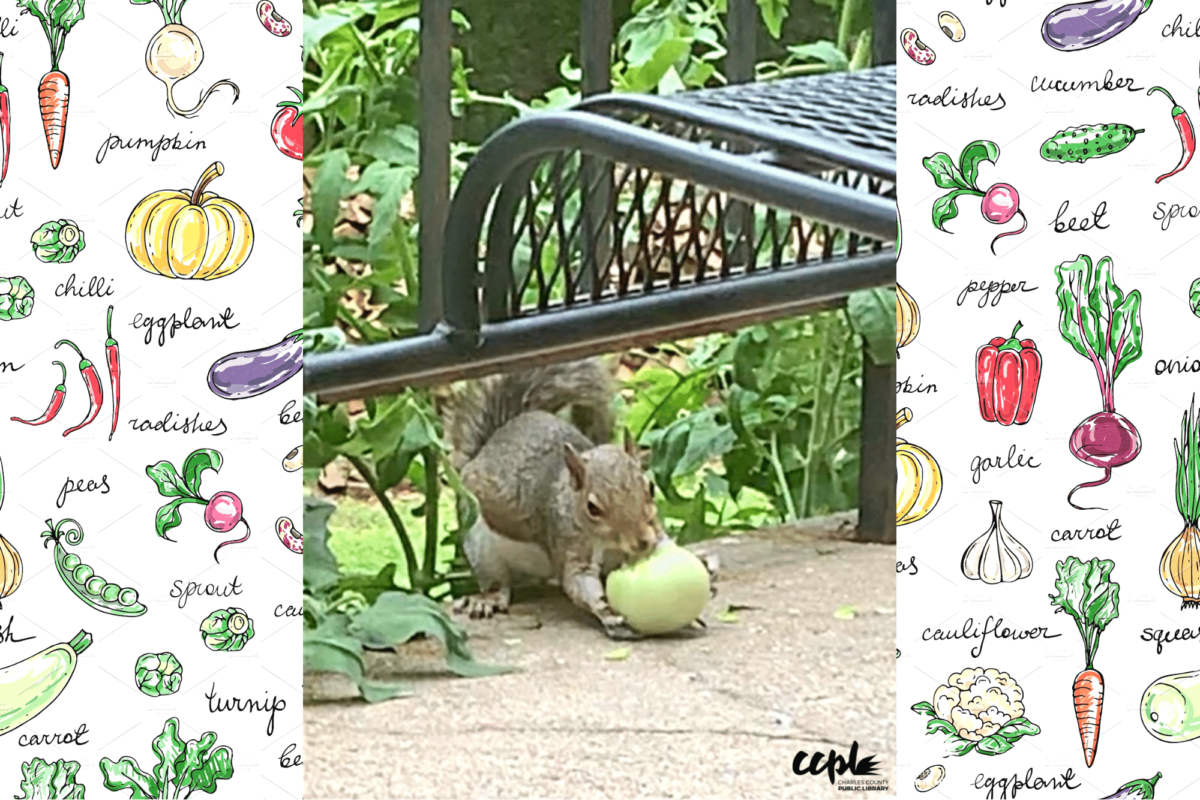
Below are tips and tricks for effective gardening from my good friend, Andrea (she is an expert gardener!):
- Tulle and deer netting can be used to protect baby (new or “true”) leaves as they begin to develop and open up. Tulle should be wrapped around the actual plants, and deer netting around the entire perimeter, anchored by stakes and/or rocks.
- There are beneficial bugs for your garden, such as bees – which are wonderful pollinators. For more on this topic, check out Garden Allies: The Insects, Birds & Other Animals That Keep Your Garden Beautiful and Thriving by Frédérique Lavoipierre.
- Spearmint, lavender and peppermint act as deterrents for pests (be sure to plant them in pots or use essential oil/spray on and around plants, as planting directly into the ground will cause them to become invasive and grow out of control).
- Fish gardening: Native Americans knew that the secret to bountiful crops was fish fertilizer – fish heads, the entire fish, sardines, etc. can be planted directly below plants for nitrogen and calcium-rich soil. Use one fish head/one fish per 15-18 inch area of soil.
- Marigolds deter most pests like rabbits, mosquitos, cabbage worms, etc.
- Sweet potatoes are a good plant for shady areas (sweet potatoes and sunflowers also have edible leaves, as well as their seeds).
- Companion gardening: Another ancient Native American trick uses the Three Sisters technique (usually with beans, squash and corn, but sometimes also with sunflowers and pumpkins).
- Vertical gardening: If you are tight on space, consider growing up instead of out, by utilizing lattice pergolas and trellises. Certain vegetables can be grown vertically, and there are also many benefits to this type of gardening. For more on this topic, check out Vertical Vegetables: Simple Projects That Deliver More Yield In Less Space by Amy Andrychowicz.
Part IV: Farmer’s Markets and Farm Stands: Local Resources (Fresh Produce)
Buying locally grown produce is a great alternative to shopping at the grocery store. It provides health benefits, using less (or no) chemicals and pesticides and guaranteeing freshness. Also, the produce is often picked at peak ripeness when it is most dense with nutrients. It may even help to reduce environmental impact, among many other perks.
(Website): Southern Maryland Agricultural Development Commission (SMADC):
Directory of regional farmers markets, farm stands, stores, and CSAs (Community Supported Agriculture).
“Welcome to the online edition of the So. Maryland, So Good: Buy Local Guide. Search the interactive guide by county to locate farm markets in your area and find ‘need to know’ market details—season openings and business hours, location maps, market websites and social media links, plus information on online orders and payment options. Bold keys identify which markets, stands and stores accept Federal Nutrition Benefits, and look for the ‘Maryland Market Money’ program logo on participating markets that offer matching dollars for purchases made using SNAP/EBT/P-EBT, eWIC, and Senior and WIC Farmers Market Nutrition Program (FMNP) benefits.”
Please click here to visit the SMADC website and browse a list of local farmer’s markets and farm stands, by county.
Resources:
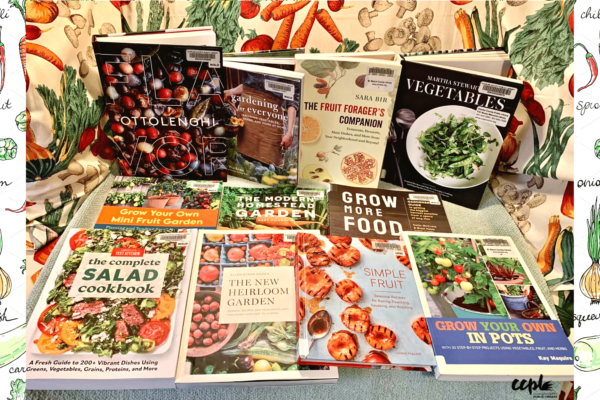
You may also check out our CCPL catalog for more information on building the perfect bowl, recipes for fruits and vegetables and tips for gardening such as:
- Bowls: Vibrant Recipes with Endless Possibilities by America’s Test Kitchen
- Build-a-Bowl: Whole Grain + Vegetable + Protein + Sauce = Meal by Nicki Sizemore
- Great Bowls of Food: Grain Bowls, Buddha Bowls, Broth Bowls and More by Robin Asbell
- The Complete Salad Cookbook: A Fresh Guide to 200+ Vibrant Dishes Using Greens, Vegetables, Grains, Proteins, and More by America’s Test Kitchen
- The Mighty Bean: 100 Easy Recipes That Are Good for Your Health, the World and Your Budget by Judith Choate
- Oh She Glows for Dinner: Nourishing Plant-Based Meals to Keep You Glowing by Angela Liddon
- Vegan, at Times: 120+ Easy Recipes for Every Day or Every So Often by Jessica Seinfeld with Sara Quessenberry
- Practically Vegan: More than 100 Easy, Delicious Vegan Dinners on a Budget: A Cookbook by Nisha Melvani
- The Budget-Friendly Vegan Cookbook: Healthy Meals for a Plant Based Diet by Ally Lazare
- Simple Fruit: Seasonal Recipes for baking, Poaching, Sauteing and Roasting by Laurie Pfalzer
- The Fruit Forager’s Companion: Ferments, Desserts, Main Dishes and More from Your Neighborhood and Beyond by Sara Bir
- Juice Manifesto by Andrew Cooper
- The Vegetable Butcher: How to Select, Prep, Slice, Dice and Masterfully Cook Vegetables from Artichokes to Zucchini by Cara Mangini
- Brassicas: Cooking the World’s Healthiest Vegetables: Kale, Cauliflower, Broccoli, Brussels Sprouts and More by Laura B. Russell
- A Girl and Her Greens: Hearty Meals from the Garden by April Bloomfield
- Martha Stewart’s Vegetables: Inspired Recipes and Tips for Choosing, Cooking and Enjoying the Freshest Seasonal Flavors from the editors of Martha Stewart Living
- Ottolenghi Flavor by Yotam Ottolenghi, Ixta Belfrage, with Tara Wigley
- Grow Your Own in Pots: With 30 Step-by-Step Projects Using Vegetables, Fruit and Herbs by Kay Maguire
- Grow Your Own Mini Fruit Garden: Planting and Tending Small Fruit Trees and Berries in Gardens and Containers by Christy Wilhelmi
- What’s Wrong With My Fruit Garden? 100% Organic Solutions for Berries, Trees, Nuts, Vines and Tropicals by David Deardorff and Kathryn Wadsworth
- The New Heirloom Garden: Designs, Recipes and Heirloom Plants for Cooks Who Love To Garden by Ellen Ecker Ogden
- The Modern Homestead Garden: Growing Self-Sufficiency in Any Size Backyard by Gary Pilarchik
- Grow More Food: A Vegetable Gardener’s Guide to Getting the Biggest Harvest Possible from a Space of Any Size by Colin McCrate & Brad Halm
- Gardening for Everyone: Growing Vegetables, Herbs and More at Home by Julia Watkins
- Mid-Atlantic Fruit & Vegetable Gardening: Plant, Grow and Harvest the Best Edibles by Katie Elzer-Peters
- Garden Allies: The Insects, Birds & Other Animals That Keep Your Garden Beautiful and Thriving by Frédérique Lavoipierre
………………………
Image credits:
Unless otherwise noted and/or linked, all images were shot during the making of this blog.

